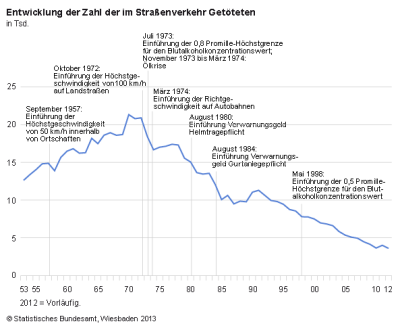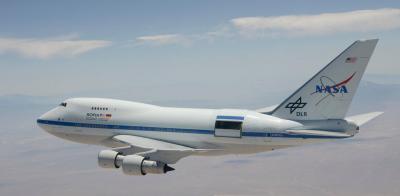Es ist schrecklich und kaum zu glauben, dass bis weit in die 1990er Jahre über 10.000 Menschen auf bundesdeutschen Straßen zu Tode kamen. Noch erschütternder: um 1970 waren es gar 21.332. Da nimmt es fast wie ein Wunder aus, dass die Todesziffer im Straßenverkehr im Jahr 2012 bei 3606 lag, wie das Statistische Bundesamt gerade meldete.

Die meisten tödlichen Unfälle (60%) ereignen sich auf Landstraßen, nur 29% innerorts. Pro Tag sterben 10 Menschen und verletzen sich über 1.000 auf unseren Straßen. Zuviele.
Unglücke im Verkehr lassen sich ähnlich wie Unfälle im Haushalt nicht ganz verhindern. Eine ganze Reihe an Regeln, Gesetzen, Normen, technischen Fortschritten und Verhaltenweisen haben geholfen, Unfälle zu vermeiden oder Unfallfolgen abzuschwächen. Etwa: Geschwindigkeitsbeschränkungen, Promillegrenzen, Gurtpflicht, aber auch Airbag oder Fahrtdynamikkontrolle (aka ESP). Meist kam die Fahrzeugsicherheit den Insassen zugute. Jetzt ist es auch an der Zeit, meine ich, den Passantenschutz deutlich zu verbessern. Evtl. hilft da nur das automatische Erkennen von Fußgängern mit Sensoren und Kameras. Das wird bei kleinen und leisen Elektroflitzern wichtig werden.
Seit November 2012 fährt in Stuttgart auch Car2Go, ein Projekt des Unternehmens Daimler. Das Besondere: Es sind ausschließlich elektrische Smarts, rund 300 Stück, die statistisch über das Stadtgebiet verteilt sind. Der Start in den Winter ist ambitioniert, die Batterie-Fahrzeuge müssen bei tagelangem, leichtem Dauerfrost funktionieren. Das scheint zu klappen. Zweimal hatte ich das ausprobiert. Was mich erstaunte, ein Fahrzeug wies bei 90 Prozent Batterieladung eine Reichweite von 71km aus, das zweite bei 70 Prozent eine Reichweite von 54km. Das ist nicht viel. Ich habe daher Andreas Leo von Car2Go gefragt,
Wie groß ist die Reichweite bei Vollaufladung?
Leo: 145 km
Welchen Anteil hat die Rekuperation an der Reichweite?
Leo: Der Smart fortwo electric drive verfügt über eine variable Rekuperationsfähigkeit, die von Fahrgeschwindigkeit, SOC, Temperatur, Brems- und Gaspedalstellung bestimmt wird. Je nach Situation kann die Reichweite dadurch um 25 bis 30 Prozent beeinflusst werden.
Wie lange dauert das Vollaufladen?
Leo: Haushaltssteckdose: ca. 7 Stunden, Wallbox: ca. 6 Stunden, Wallbox + 22kW-Lader: < 1 Stunde
Leo schränkt allerdings ein, dass es für eine genaue Auswertung der Daten seit November 2012 noch zu früh sei, die Angaben also allgemeine Schätzwerte seien.
Den Komfort, das Car-Sharing-Fahrzeug direkt vom Wegesrand zu buchen und bis zum Ziel zu fahren (das muss allerdings im Stadtgebiet liegen), finde ich unschlagbar. Das lohnt sich für Strecken, die nicht direkt mit dem ÖPNV erreichbar sind -- also etwa nur per Umsteigen. Ansonsten ist Car2Go wohl teurer als die Fahrt im Nahverkehr. Für 7 Kilometer in 17 Minuten (mit 29ct pro Minute) kostet Car2Go knapp 5 Euro. Da muss jeder selbst abwägen.
Im Berufsverkehr oder durch die Innenstadt ist von Car2Go abzuraten (U- und S-Bahnen fahren an Stau und Ampeln vorbei). Auf jeden Fall ist das flexible Car-Sharing-Angebot eine Bereicherung für die individuelle Mobilitätsplanung.
Und nochwas: Car2Go hat aktuell in Stuttgart rund 10.000 Nutzer bei einer Fahrzeugflotte von 300 Zweisitzern, das macht also ein Verhältnis von 100:3. Wenn also gerade bei jungen Internet- und Smartphone-affinen Menschen das Car-Sharing an Attraktivität gewinnt und das 'eigene' Auto entsprechend verliert, freue ich mich darauf, dass unsere Straße und Wege bald weniger mit Blech zugestellt sind.
"Freikolbenlineargenerator" klingt alles andere als sexy. Das Wort ist eher ein Zungenbrecher und typisch Ingenieurs-Sprech. Dabei beschreibt es ziemlich genau, was mit Frei-Kolben-Linear-Generator gemeint ist: Ein freier Kolben schwingt in einem Verbrennungsmotor hin und her, wobei die lineare Bewegung einen Generator antreibt. Kurz: das Teil erzeugt Strom.

"Freikolbenlineargenerator à la DLR" klingt noch sperriger. Das Prinzip ist zwar Jahrzehnte alt, Forscher am Deutschen Zentrum für Luft- und Raumfahrt (DLR) haben aber gerade einen ersten Demonstrator präsentiert. Da stellt sich die Frage der Namensgebung.
Vorbei scheinen die Zeiten als Forscher und Erfinder noch ihre Marken und Ideen mit eigenem Namen prägten: Mercedes (die Tochter), Daimler (Gottlieb), Benz (Karl), Opel (Adam), Porsche (Ferdinand), aber auch Otto (Nicolaus August), Diesel (Rudolf), Wankel (Felix) oder Sterling (Robert).
Dabei bieten die DLR-Forscher in Stuttgart mit Horst Friedrich, Frank Rinderknecht oder Florian Kock (die aktuellen Projektverantwortlichen) auch interessante Möglichkeiten. Wie wäre es mit Horst-Motor, Rinderknecht-Generator oder Kock-Aggregat. Alternativ auch das Horst-Rinderknecht-Kock-Prinzip - doch das wäre genauso unhandlich wie der Freikolbenlineargenerator.
wird es bald keinen Fisch mehr geben." Der Kunststudent Uli Streckenbach aus Halle hat eine tolle Animation zum Thema Überfischung der Meere ins Netz gestellt: Die Überfischung der Meere
Wednesday, around 5pm the 747 with SOFIA took off for the U.S. again. On board, Nasa test pilot Troy Asher. A couple of hours ago he had sent me an e-mail regardings some questions on flying the Stratospheric Observatory for infrared Astronomy (SOFIA).
Troy, what is different to fly the 747SP/SOFIA platform from flying a normal jumbo jet?
It is very much the same as flying a normal 747 or other very large jet with a few small exceptions. First of all, having this large 4m x 4.6m door open on the back of the airplane is hardly noticeable. Most people on the airplane cannot tell at all when the door is open or closed. The aerodynamics engineers who designed the door and the surrounding opening did a fantastic job.
Do you have to perform special flight maneuvers during measurement? When the 'door' is open?
The main difference between flying SOFIA and a normal jumbo jet is in the way we fly it during an astronomical observation. The flight maneuvers are not difficult, just very exacting and sometimes even monotonous.
We are very sensitive about the weather. Because the 2.5m mirror is a highly sensitive, one-of-a-kind object, we treat it with extreme care. If there is blowing dust, any kind of rain or other contaminants in the air, we do not open the door and in some instances, we won't even takeoff. We cannot fly in clouds with the door open and we try to avoid anything greater than light turbulence. Also, because the mirror is such a great reflector of focused light, we avoid flight during the daytime. We always plan to wait until sunset to open the door and always plan to be on the ground before sunrise, just in case the telescope door might not close when we ask it to. Direct sunlight on the mirror can create light so focused that it will damage other sensitive components of the telescope assembly or possibly even the aircraft structure. So it's a night-time job.
The telescope is pointed in large part by the attitude of the aircraft. In order to keep the telescope locked on to a far away object, we must maintain our heading to within 1-degree and keep our bank angles to no more than 2-degrees. Because it requires a curved flight path to stay locked on to a distant object, we are continuously making 1-degree heading changes by using very small bank angles...for 10 hours at a time. Also, airspeed changes must be made very smoothly as changing power settings on the engines can cause the nose of the aircraft to rise or fall which also interferes with telescope pointing. Don't make any sudden moves as a SOFIA pilot!
Because there tends to be less water vapor in the air at higher altitudes, we generally fly as high as the airplane will physically go. For a normal jumbo jet, you would fly at the most efficient altitude for the weight of the airplane, but not with SOFIA -- we fly as high as the engines will take us at any given time. This requires very precise airspeed control (which is 0.85 Mach number) because we have a 0.87 Mach upper speed limit, to reduce fatigue on the telescope door, and a lower airspeed of about 0.82 Mach, slower than which we have difficulty maintaining altitude. So the operating conditions for the aircraft lie in a very narrow band that has to be constantly monitored.
How does the crew schedule flights?
Planning for one of our missions is a very involved process. Our mission planners use a specialized computer system to calculate where the telescope would need to be pointed to observe a desired object. They work backwards taking into account orbital dynamics, winds, temperatures, and many other factors to calculate exactly where over the Earth's surface and at precisely what time the aircraft needs to fly so we can find the object we are looking for in the telescope. Their plan is continuously updated for changing weather conditions right up until takeoff time. This means that we never really know where the airplane is going to fly until just before takeoff. This makes coordinating flight plans with Air Traffic Control challenging and makes for some hectic times right before takeoff due to last minute changes.
Then, once we are flying, we must control our timing such that we arrive at the point where we will begin astronomy at exactly the calculated time. Once locked on, the aircraft must maintain precise headings and if the winds turn out to be different than we planned, the airplane does not travel to the points we originally planned. This creates other challenges with Air Traffic Control as well as other airplanes flying in our vicinity. Luckily, we always fly in the middle of the night, so Air Traffic Control is fairly kind to us due to lighter air traffic. That's one good thing about working the graveyard shift.
 Molecules vibrate in the infrared (ir) range of the electromagnetic 'light' spectrum. Sadly enough, earth's atmosphere is filtering most of the ir light from distant stars and galaxies by its own vibrating gas molecules, mostly water. Hence, you have to lift an ir telescope above the atmosphere to get a clear ir view - by a balloon, a satellite, or an airplane. Image (c) Nasa.
Molecules vibrate in the infrared (ir) range of the electromagnetic 'light' spectrum. Sadly enough, earth's atmosphere is filtering most of the ir light from distant stars and galaxies by its own vibrating gas molecules, mostly water. Hence, you have to lift an ir telescope above the atmosphere to get a clear ir view - by a balloon, a satellite, or an airplane. Image (c) Nasa.
Nasa and the German aerospace center, DLR, planned and built over more than a decade the SOFIA platform - a refurbished Jumbo 747SP. The plane is more then 30 years old. In the back, a 2.7 ton telescope is built-in. During night flights scientists may open some kind of back door to watch the ir sky. Operating altitude is about 13 to 14 kilometers at a speed around 800 km/h.
On Monday the 747SP touched down at Stuttgart airport. I checked in for a visit, talking to some of the scientists.
Jürgen Stutzki of Cologne University (Universität zu Köln) just came on a SOFIA over-night flight to Germany. During the measurement he and his team aligned the telescope to star forming discs picking up signals from small molecules like H-C.
The most impressive quote did Hans-Peter Röser, the German mastermind behind the SOFIA project and scientist at Stuttgart University: "The task of SOFIA is like speeding up a Porsche to 200 km/h and touching a coin with a laser pointer in a distance of 60 km."
Links:
The German SOFIA institute at Stuttgart University http://www.dsi.uni-stuttgart.de
A colleague's report from the flight from California to Germany http://www.spiegel.de/wissenschaft/weltall/0,1518,787002,00.html
The following picture goes inside the 747SP showing the desk of the principal scientific investigator (PI), laptops and far right and blueish the sealed circular telescope box. Image (c) martin_

Liebe Leute, nach mehrjährigen Ausflügen auf einer eigenen Antville-Plattform, bei 'twoday.net' und 'typolis.net' ziehe ich hier im Mutterhaus 'antville' wieder ein und schreibe weiter...
Hi folks, after running my own antville server, blogging at 'twoday.net' and 'typolis.net', I'm going back to the roots, and continue writing at this site...
Last update 02.01.2024



